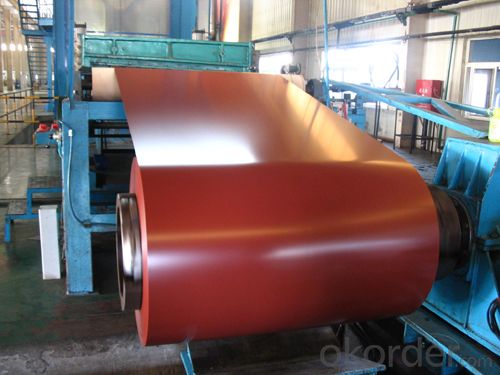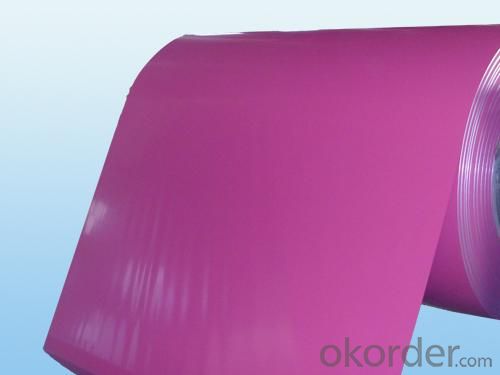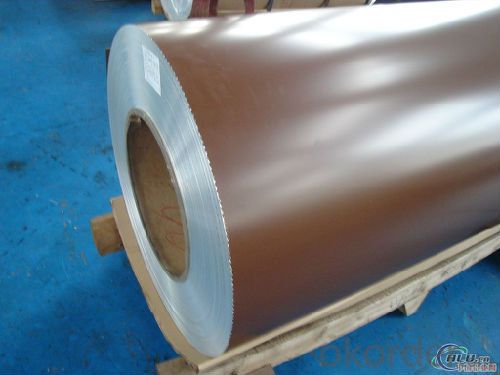PVDF Color Coated Aluminium Coils for Decoration AA3003
- Loading Port:
- China Main Port
- Payment Terms:
- TT or LC
- Min Order Qty:
- -
- Supply Capability:
- -
OKorder Service Pledge
OKorder Financial Service
You Might Also Like
1.Structure of Product Description
PVDF Coated aluminium coils are widly used in decoration field. For the paints, there are two kinds: One is Polyester, and the other is PVDF. The price of PVDF is much higher than PE. However, the period of PVDF will be last longer, it can be remain 15-20 years. Compared to PE, it is 10-15 years.
2. Main features of the product
a.Competitive price---We have our own mills and can produce mill finished aluminium coils, so we can control the production cost better.
b.Professional after-sale service---We have more than 15 years exportation experience and you need not worry about the exporation problems.
c.Fast delivery time---We can control the delivery time within 35 days.
3. Image



4.Products Specification
| Alloy | Temper | Painting | Coil ID | Coil Weight |
| AA3003 | H14,H16,H18 | PVDF | 508MM | 2-2.5 TONS |
5.FAQ:
What is the quality standard?
---Usually our standard is GB3880-2006
What is the largest width?
---It is 2300mm
What is the MOQ?
---Usually we can accept 80 tons.
- Q:Aluminum metal reacts with hydrochloric acid, HCl, to form hydrogen gas (H2) and a solution of aluminum chloride. Write and balance the equation. Can someone help I just dont get this Al2 + 6HCl → 3H2 + 2AlCl3 Al2 + 2HCl → H2 + 2AlCl 2Al + 6HCl → 3H2 + 2AlCl3 Al + 2HCl → H2 + AlCl2 6Al + 2HCl → H2 + 2Al3Cl
- 2NH4Cl+Ca(OH)2-CaCl+2NH3+2H2O 18 Zn+2Cl-ZnCl2+H2 19 F2+2NaCl-2NaF+Cl2 20 CaO+SO2-CaSO3 21 2CaSO3+O2-2CaSO4 22 2HgO-2Hg+O2 23 CH3OH-CO+2H2 24 2KNO3-2KNO2+O2 you put the question in wrong section. Answer the others by yourself. I have given lots of examples there.
- Q:Can aluminum coils be used for HVAC ducting?
- Yes, aluminum coils can be used for HVAC ducting. Aluminum is a popular choice for ducting due to its lightweight nature, corrosion resistance, and ability to efficiently transfer heat. It is commonly used in both residential and commercial HVAC systems.
- Q:How do aluminum coils compare to titanium coils in terms of weight?
- Aluminum coils are significantly lighter in weight compared to titanium coils. Aluminum has a lower density than titanium, which means that the same volume of aluminum weighs less than titanium. This characteristic makes aluminum coils a preferred choice in various industries where weight reduction is crucial, such as aerospace and automotive applications. Titanium coils, on the other hand, are known for their exceptional strength and high corrosion resistance, making them suitable for environments where durability is a priority. Ultimately, the choice between aluminum and titanium coils depends on the specific requirements and trade-offs desired for a particular application.
- Q:What is the elongation of aluminum coils?
- The elongation of aluminum coils refers to the amount of stretching or deformation that can occur in the material before it breaks or becomes permanently damaged. It is a measure of the ductility or ability of aluminum to withstand tensile forces without fracturing.
- Q:Can aluminum coils be anodized for enhanced durability?
- Yes, aluminum coils can be anodized to enhance their durability. The anodizing process creates an oxide layer on the surface of the aluminum, making it more resistant to corrosion, wear, and abrasion. This improves the overall lifespan and performance of the coils.
- Q:Can aluminum coils be used in low-friction applications?
- Low-friction applications can indeed make use of aluminum coils. Aluminum, being a lightweight and corrosion-resistant material, exhibits excellent thermal conductivity. These characteristics render it suitable for a variety of applications that prioritize low-friction. The automotive, aerospace, and HVAC industries often employ aluminum coils in heat exchangers, evaporators, condensers, and cooling coils. These coils are specifically designed to efficiently transfer heat while minimizing friction and energy loss. Furthermore, aluminum coils find utility in electrical motors, generators, and transformers, where smooth operation and reduced energy consumption are vital. Additionally, the lightweight nature of aluminum contributes to overall system weight reduction, thereby increasing efficiency. Moreover, various types of machinery and equipment that necessitate low friction, such as conveyor systems, sliding mechanisms, and bearings, can benefit from the utilization of aluminum coils. Aluminum's low coefficient of friction enables smooth and efficient movement, minimizing wear and tear on components. In conclusion, aluminum coils offer versatility in low-friction applications due to their lightweight, corrosion-resistant, and thermally conductive properties. Incorporating these coils can result in improved energy efficiency, reduced maintenance costs, and enhanced performance across a wide range of industries.
- Q:What is the typical thermal conductivity of aluminum coils?
- The typical thermal conductivity of aluminum coils is approximately 205-220 W/mK. Aluminum is known for its excellent thermal conductivity, making it a popular choice for heat transfer applications such as in HVAC systems, refrigeration, and heat exchangers. The high thermal conductivity of aluminum allows for efficient heat dissipation and transfer, ensuring optimal performance and energy efficiency in these systems.
- Q:Are aluminum coils suitable for architectural applications?
- Yes, aluminum coils are suitable for architectural applications. Aluminum is a highly versatile and durable material that is commonly used in the construction industry for various architectural applications. Aluminum coils offer several advantages for architectural use, including their lightweight nature, corrosion resistance, and ability to be easily formed into desired shapes and sizes. These coils can be used in architectural applications such as roofing, cladding, facades, and gutters, among others. Additionally, aluminum coils can be coated with different finishes, providing a wide range of aesthetic options for architects and designers. Overall, aluminum coils are an excellent choice for architectural applications due to their strength, durability, and flexibility.
- Q:What are the common safety precautions when working with aluminum coils?
- When working with aluminum coils, it is important to follow several safety precautions to ensure the well-being of individuals and prevent accidents. Some common safety precautions when working with aluminum coils include: 1. Personal Protective Equipment (PPE): Always wear appropriate PPE such as safety goggles, gloves, and aprons when handling aluminum coils. This protective gear helps protect against potential injury from sharp edges, cuts, or burns. 2. Proper Handling Techniques: Use proper lifting techniques to avoid strain or injury. Aluminum coils can be heavy, so it is essential to lift with your legs, not your back, and use lifting aids or equipment if necessary. 3. Secure Storage: Store aluminum coils securely to prevent them from falling or rolling. Avoid stacking coils too high to prevent them from toppling over and causing injuries. 4. Proper Ventilation: Ensure that the work area has adequate ventilation to prevent the buildup of fumes or dust particles. Aluminum coils may release harmful particles or gases when cut or processed, so proper ventilation is crucial for maintaining a safe working environment. 5. Fire Safety: Aluminum is highly flammable, so it is vital to prevent sparks or open flames near aluminum coils. Use non-sparking tools and avoid smoking or using flammable materials in the vicinity. 6. Sharp Edges: Be cautious of sharp edges on aluminum coils, as they can cause cuts or lacerations. Handle coils with care and use appropriate tools to mitigate the risk of injury. 7. Training and Safety Guidelines: Ensure that all personnel working with aluminum coils are properly trained in handling procedures and safety guidelines. This includes understanding the correct use of equipment, emergency procedures, and knowledge of any specific hazards associated with aluminum coil handling. 8. Regular Maintenance: Maintain equipment and tools regularly to ensure they are in good working condition. This includes inspecting and repairing any damaged or worn-out parts that could pose a safety risk. 9. First Aid and Emergency Response: Keep a well-equipped first aid kit nearby and ensure that employees are aware of its location. In addition, establish clear emergency response protocols and train employees on what to do in case of an accident or injury. By adhering to these common safety precautions, individuals can minimize the risks associated with working with aluminum coils and create a safer working environment.
- Q:I have a broken exhaust stud in my engine head. I have an aluminum head but the stud is steel. The stud broke a little below the surface. I want to mig weld a washer to the stud, but will the weld stick to the aluminum or will it blow a big hole in the head? I will only be using a little 110 mig welder.will I be okay or will that lead to more problems?
- It will blow a big hole in it if you touch it with the arc. Drill a hole in it sized for an easy out. Use that to unscrew it. Go to an auto parts store or good hardware store. They will know what an easy-out is. Make sure you don't drill the hole too big and it must be centered or you will damage the threads. If that happens you can drill it out bigger and get a thread insert, but that will be harder for you to find.
1. Manufacturer Overview |
|
|---|---|
| Location | |
| Year Established | |
| Annual Output Value | |
| Main Markets | |
| Company Certifications | |
2. Manufacturer Certificates |
|
|---|---|
| a) Certification Name | |
| Range | |
| Reference | |
| Validity Period | |
3. Manufacturer Capability |
|
|---|---|
| a)Trade Capacity | |
| Nearest Port | |
| Export Percentage | |
| No.of Employees in Trade Department | |
| Language Spoken: | |
| b)Factory Information | |
| Factory Size: | |
| No. of Production Lines | |
| Contract Manufacturing | |
| Product Price Range | |
Send your message to us
PVDF Color Coated Aluminium Coils for Decoration AA3003
- Loading Port:
- China Main Port
- Payment Terms:
- TT or LC
- Min Order Qty:
- -
- Supply Capability:
- -
OKorder Service Pledge
OKorder Financial Service
Similar products
New products
Hot products
Related keywords






























